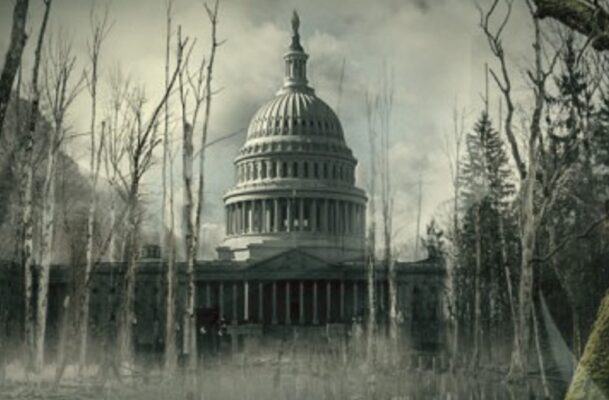Although the federal administrative state probably existed before the Franklin Roosevelt administrations, those administrations ushered in a large expansion of federal agencies and more and more have arisen almost continuously thereafter.
The federal administrative state is populated and effectively controlled by unelected bureaucrats who seemingly ignore the policy will of voters expressed in presidential and congressional elections. Thus, changes in administrations in Washington frequently do not result in meaningful changes in the administrative bureaucracy and its rules and regulations.
Efforts to Drain the Swamp are usually hampered in large measure by the existing federal administrative bureaucracy.
Unfortunately, the Supreme Court of the United States effectively expanded the powers of the administrative state in 1984 in its so-called Chevron decision.
The research department of the Federal Reserve Bank of Richmond, an integral part of the Federal Reserve system, regularly publishes a variety of research papers, including a magazine named “Econ Focus.” The latest issue contains the following article, reprinted with permission, by contributor Sam Louis Taylor, on the so-called Chevron Doctrine, which appears to be a very cogent explanation of the Chevron Doctrine and what might be coming in the future for us regarding it.
[Please note that the views expressed in Econ Focus are those of the contributors and not necessarily those of the Federal Reserve Bank of Richmond or the Federal Reserve System.]
“Following the will of Congress is often a complicated endeavor for regulators, especially when lawmakers leave aspects of a regulatory law unclear. That uncertainty often leads to litigation.
But how should courts determine if an administrative agency has gone outside the bounds of the law when designing regulations? This is an important question for regulators, like the Fed, that have been charged with implementing laws passed by Congress.
In the 1984 landmark case Chevron U.S.A., Inc. v. Natural Resources Defense Council, Inc. the court established a process to determine whether an agency has acted properly in creating a regulation in the face of legislative uncertainty. This concept, commonly referred to as Chevron deference, has been a critical legal concept that has governed how courts oversee the regulatory process for the past 40 years.
In January, the Supreme Court heard arguments in two cases that could overturn Chevron and set out new expectations for how agencies should implement laws passed by Congress.
In Chevron, the Supreme Court established a two-part test to determine the lawfulness of a regulation. First, when a regulation is being challenged, a court will determine if Congress has spoken clearly on the matter. “If the intent of Congress is clear, that is the end of the matter.” But if Congress does not clearly state how it wants a statute to be implemented, then courts should defer to an agency’s interpretation of the statue that is within its administration so long as it is a “permissible construction” of the law. The court based this deference on three reasons: ambiguity in a statute amounts to an implicit delegation of authority by Congress to an agency to resolve outstanding questions of implementation; an agency has greater subject matter expertise than courts to resolve this ambiguity; and an executive branch agency is a better venue for reconciling “competing political interests” than the courts because the president has greater political accountability.
The Supreme Court has combined two cases in its current term, Relentless, Inc. v. Department of Commerce and Loper Bright Enterprises v. Raimondo, in which two herring fishing companies have challenged a rule from the National Marine Fisheries Service that requires the industry to pay for on-board observers to monitor federal conservation efforts. Lower courts cited Chevron in rejecting the companies’ challenges. The petitioners have asked the Supreme Court to overrule Chevron or at least significantly curtail the deference given to agency determinations.
What would be the impact of ruling against the government in these cases?
Legal scholars have predicted that agencies could become more constrained in their interpretations of statutes and more hesitant to create regulations in response to new and emerging issues without going to Congress for more authority. Experts have also observed that Congress would need to clearly state its intent when drafting laws or be willing to come back and tackle new issues as they arise. There are also predictions that regulations would more often be challenged in court because agencies could not count on judicial deference to their interpretations of statutes.
There are many in the political and legal sphere who see these potential changes as a feature, not a drawback, of overturning Chevron. In an amicus brief led by Sen. Ted Cruz, R-Texas, Republican members of Congress have argued that Chevron has inappropriately expanded the role of agencies into policymaking, a power reserved for Congress. “Over time, it’s proven to be a harmful precedent because it shifts decision making away from democratically elected members of Congress to the permanent members of the bureaucracy,” the Republican members of Congress argued.
Others have argued that Congress purposefully provided agencies with leeway to respond to new threats that it could not have anticipated. A brief filed by Sen. Sheldon Whitehouse, D-R.I., on behalf of a group of Senate Democrats stated, “As industries grew more complex, Congress delegated some regulatory authority to administrative agencies. Chevron deference has been an important element in this endeavor, allowing Congress to rely on agency capacity and subject matter expertise to help carry out Congress’s broad policy objectives.”
Regulators and other interested parties will be following the ruling closely to better understand the limits courts are likely to impose on the way agencies operate in the future.”
